最新深圳小学英语四年级下册知识点复习
深圳市沪教牛津版四年级英语(下)册知识点总结

Unit1Touch and feel1.学会询问触觉感受的句子,如:Touch this.How does it feel?2.学会使用一些形容词来描述物品的特点,如:It’s soft./It’s hard.3.学会根据触觉来猜测物品,如:—It's hard.—What is it?—Is it an apple?—Yes,it is.touch碰;触摸feel摸起来;感到soft柔软的hard坚硬的thick厚的;粗的thin薄的;细的hear听到young年轻的noise响声;吵闹声men男人(复数)blind瞎的;失明的1.—Touch this,Alice.How does it feel?摸摸这个,Alice。
感觉它是怎样的?—It's soft.它是软的。
2.Well done!做得很好。
Unit2Smell and taste1.学会使用“看”、“闻”和“尝”三个感官动词,如:①Look,Joe.②Smell this.③Taste it.2.学会使用选择疑问句,如:Is it strawberry juice or watermelon juice?3.学会使用形容词来对事物进行描述和判断,如:It's sweet and sour.It’s strawberry juice!grape葡萄strawberry草莓watermelon西瓜juice果汁smell闻;嗅taste品尝sweet甜的sour酸的or或者;还是wait等待;等候minute一会儿;分钟get得到fox狐狸round圆的purple紫色的those那些1.I have some juice here.我这儿有些果汁。
2.Smell this.闻闻这个。
3.Is it strawberry juice or watermelon juice?这是草莓汁还是西瓜汁?4.Taste it.尝尝它。
沪教牛津版(深圳用)四年级英语下册Unit 3 Look and see 看和看见 知识梳理
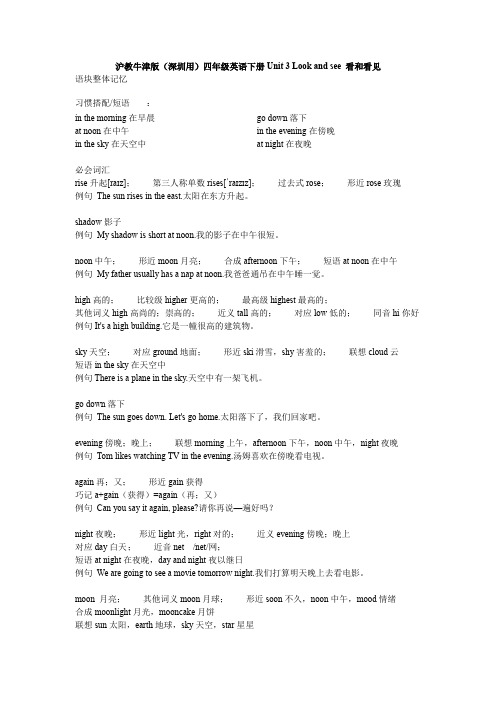
沪教牛津版(深圳用)四年级英语下册Unit 3 Look and see 看和看见语块整体记忆习惯搭配/短语:in the morning在早晨at noon在中午in the sky在天空中go down落下in the evening在傍晚at night在夜晚必会词汇rise升起[raɪz];第三人称单数rises[ˈraɪzɪz];过去式rose;形近rose玫瑰例句The sun rises in the east.太阳在东方升起。
shadow影子例句My shadow is short at noon.我的影子在中午很短。
noon中午;形近moon月亮;合成afternoon下午;短语at noon在中午例句My father usually has a nap at noon.我爸爸通吊在中午睡一觉。
high高的;比较级higher更高的;最高级highest最高的;其他词义high高尚的;崇高的;近义tall高的;对应low低的;同音hi你好例句It's a high building.它是一幢很高的建筑物。
sky天空;对应ground地面;形近ski滑雪,shy害羞的;联想cloud云短语in the sky在天空中例句There is a plane in the sky.天空中有一架飞机。
go down落下例句The sun goes down. Let's go home.太阳落下了,我们回家吧。
evening傍晚;晚上;联想morning上午,afternoon下午,noon中午,night夜晚例句Tom likes watching TV in the evening.汤姆喜欢在傍晚看电视。
again再;又;形近gain获得巧记a+gain(获得)=again(再;又)例句Can you say it again, please?请你再说—遍好吗?night夜晚;形近light光,right对的;近义evening傍晚;晚上对应day白天;近音net /net/网;短语at night在夜晚,day and night夜以继日例句We are going to see a movie tomorrow night.我们打算明天晚上去看电影。
四年级英语下册重点知识点总结

四年级英语下册重点知识点总结
四年级英语下册的重点知识点总结如下:
1. 时态动词:学习使用一般现在时、一般过去时和一般将来时来描述不同时间发生的动作。
掌握动词的基本形式和过去式,以及一般将来时的构成。
2. 句型转换:学会进行肯定句、否定句和问句的转换,掌握一般疑问句和特殊疑问句的构成。
3. 数字和计量词:学习数字的书写和发音,掌握基本的计量词,如:a few、a little、a lot of等。
4. 学校用语:掌握与学校相关的英语表达,如:教室、图书馆、操场等地方的名称,以及上课、做作业、考试等动作的描述。
5. 应急日常用语:学习一些日常英语用语,如:问候、道歉、请求帮助等,以便能够进行基本的交流和应对常见的情境。
6. 日常生活描述:学习如何用英语描述日常生活,如:描述自己的家庭、家人、爱好等。
掌握描述人物外貌、个性和能力的词汇。
7. 交通方式:学习描述不同交通工具的名称,如:车、飞机、船等,以及如何描述交通方式、交通工具的行驶方向和速度。
8. 天气和季节:学习描述天气状况和不同季节的英语表达,如:
晴天、阴天、下雨、夏天、秋天等。
9. 礼貌用语:学习基本的礼貌用语,如:谢谢、对不起、请等,以便能够与他人进行礼貌的交流。
以上是四年级英语下册的重点知识点总结,希望对你有帮助!。
深圳小学四年级下册英语复习汇总
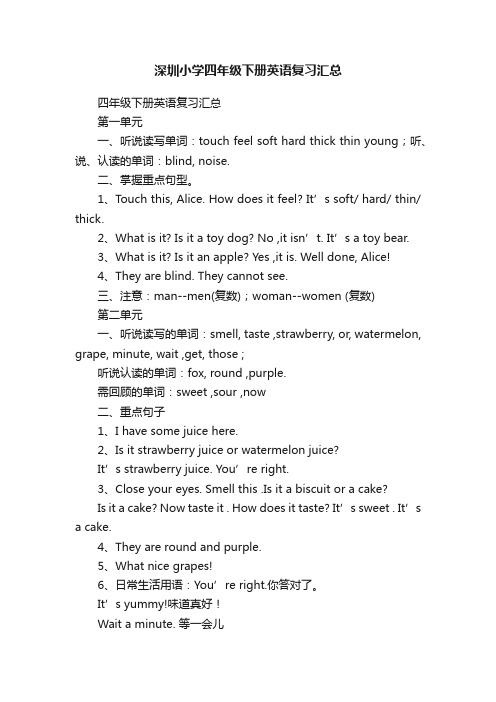
深圳小学四年级下册英语复习汇总四年级下册英语复习汇总第一单元一、听说读写单词:touch feel soft hard thick thin young;听、说、认读的单词:blind, noise.二、掌握重点句型。
1、Touch this, Alice. How does it feel? It’s soft/ hard/ thin/ thick.2、What is it? Is it a toy dog? No ,it isn’t. It’s a toy bear.3、What is it? Is it an apple? Yes ,it is. Well done, Alice!4、They are blind. They cannot see.三、注意:man--men(复数);woman--women (复数)第二单元一、听说读写的单词:smell, taste ,strawberry, or, watermelon, grape, minute, wait ,get, those ;听说认读的单词:fox, round ,purple.需回顾的单词:sweet ,sour ,now二、重点句子1、I have some juice here.2、Is it strawberry juice or watermelon juice?It’s strawberry juice. You’re right.3、Close your eyes. Smell this .Is it a biscuit or a cake?Is it a cake? Now taste it . How does it taste? It’s sweet . It’sa cake.4、They are round and purple.5、What nice grapes!6、日常生活用语:You’re right.你答对了。
2024年小学四年级英语下册知识点资料
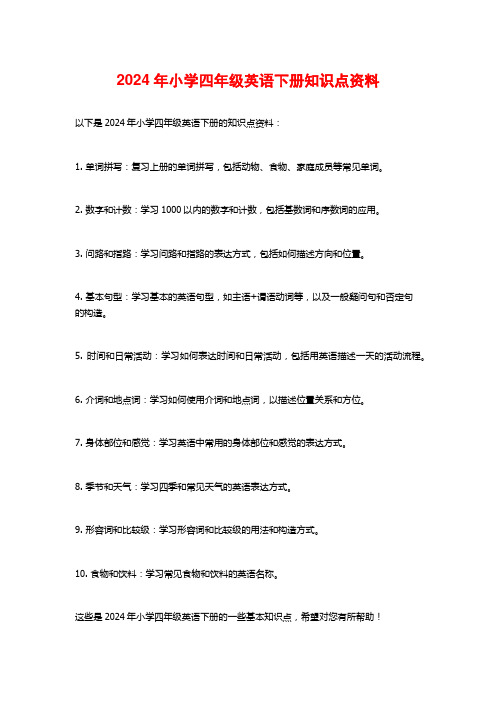
2024年小学四年级英语下册知识点资料
以下是2024年小学四年级英语下册的知识点资料:
1. 单词拼写:复习上册的单词拼写,包括动物、食物、家庭成员等常见单词。
2. 数字和计数:学习1000以内的数字和计数,包括基数词和序数词的应用。
3. 问路和指路:学习问路和指路的表达方式,包括如何描述方向和位置。
4. 基本句型:学习基本的英语句型,如主语+谓语动词等,以及一般疑问句和否定句
的构造。
5. 时间和日常活动:学习如何表达时间和日常活动,包括用英语描述一天的活动流程。
6. 介词和地点词:学习如何使用介词和地点词,以描述位置关系和方位。
7. 身体部位和感觉:学习英语中常用的身体部位和感觉的表达方式。
8. 季节和天气:学习四季和常见天气的英语表达方式。
9. 形容词和比较级:学习形容词和比较级的用法和构造方式。
10. 食物和饮料:学习常见食物和饮料的英语名称。
这些是2024年小学四年级英语下册的一些基本知识点,希望对您有所帮助!。
沪教牛津版(深圳用)四年级英语下册Unit 1 Touch and feel 触摸和感觉 知识梳理

沪教牛津版(深圳用)四年级英语下册Unit 1 Touch and feel 触摸和感觉语块整体记忆习惯搭配/短语:a toy dog/bear一个玩具狗/熊an apple一个苹果惯用语:Well done!做得好!必会词汇feel摸起来;感到;过去式felt;第三人称单数feels;形近feed喂养近音fill 装满;转化feel n.触觉;派生feeling n.感受soft柔软的;对应hard坚硬的;例句Silk feels soft.丝绸摸起来很柔软。
touch碰;触摸;第三人称单数touches;形近teach教;转化touch n.触觉例句Don't touch it!不要触摸它!hard坚硬的;其他词义hard艰难的;形近harm伤害,yard院子;对应soft柔软的例句The stone is hard.这块石头很坚硬。
thick厚的;粗的;比较级thicker更厚的;更粗的;最高级thickest最厚的;最粗的其他词义thick浓密的;形近think思考,chick小鸡;对应thin薄的;细的例句That book is very thick.那本书很厚。
thin薄的;细的;比较级thinner更薄的;更细的;最高级thinnest最薄的;最细的其他词义thin瘦的;形近then然后;对应thick厚的;粗的近音thing物,东西例句Cut the vegetables into thin strips.把蔬菜切成细条。
blind瞎的;失明的;形近blink眨眼睛;派生blindly adv.盲目地;摸黑地转化blind v.使失明;联想deaf耳聋的;例句There is a blind man over there.那边有一个盲人。
noise响声;吵闹声;形近nose鼻子;派生noisy adj.吵闹的;联想sound声音例句Don't make a noise.别出声。
深圳小学英语4下知识点总结及练习 unit 1
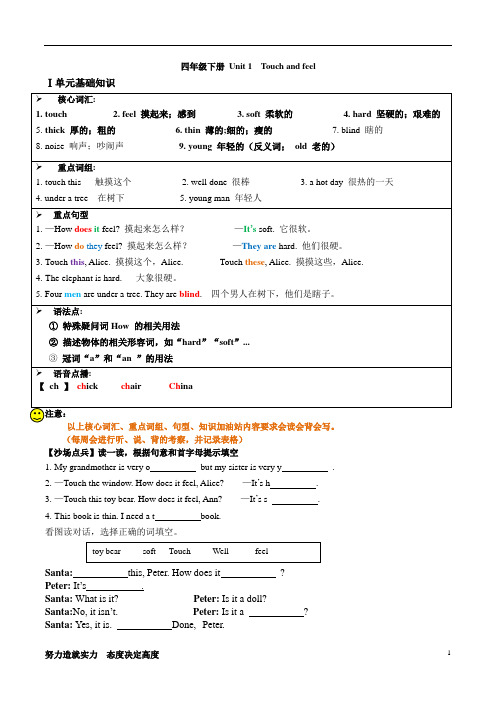
四年级下册Unit 1 Touch and feelⅠ单元基础知识(每周会进行听、说、背的考察,并记录表格)【沙场点兵】读一读,根据句意和首字母提示填空1.My grandmother is very o but my sister is very y .2.—Touch the window. How does it feel, Alice? —It’s h .3.—Touch this toy bear. How does it feel, Ann? —It’s s .4.This book is thin. I need a t book.看图读对话,选择正确的词填空。
Santa:this, Peter. How does it ?Peter: It’s .Santa: What is it? Peter: Is it a doll?Santa:No, it isn’t. Peter: Is it a ? Santa: Yes, it is. Done, Peter..Ⅱ知识详解[词汇全解]1.询问对方某物摸起来怎么样How does it feel? 它摸起来怎么样?It is soft. 它很柔软。
解析:①how 是疑问词,意为“怎样”,在这里用来询问某物摸起来的感觉②dose 在这里为助动词,是do的第三人称单数形式③feel 意为“摸起来”,可替换其他感官动词see, hear, taste, smell, touch等【复习】How的用法【拓展】How 意为“怎么样”,e.g. How are you ? 你好吗?—I’m fine. 我很好。
How old 意为“多少岁”e.g. —How old are you? 你多少岁?—I’m five years old. 我五岁。
How many 意为多少,后接可数名词,询问数量How much 意为多少,后接不可数名词常用于询问价钱。
深圳小学英语4下知识点总结及练习unit11
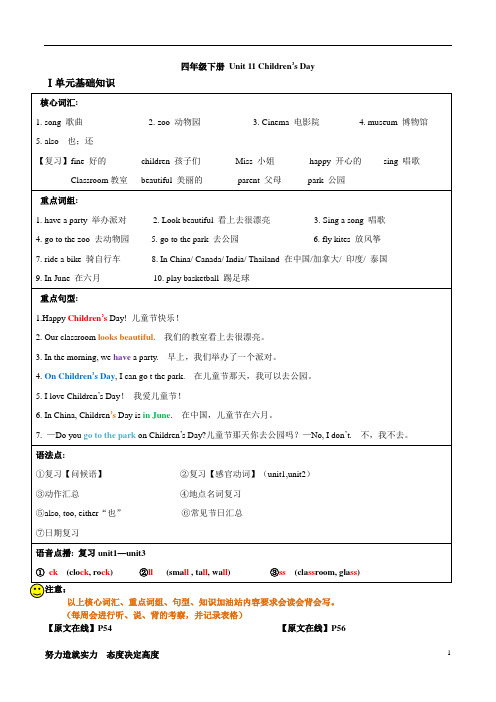
四年级下册Unit 11 Children’s Day Ⅰ单元基础知识➢➢➢1.2.3.4.5.6.7.➢➢(每周会进行听、说、背的考察,并记录表格)【原文在线】P54 【原文在线】P56Ⅱ 知识详解[词汇全解]1. 【情景交际】【汇总】【小试牛刀】( )1. 你的好朋友Ann 今天过生日,你应该对她说:My garden①It is Children ’s Day. “Hello, Jill.”“Hello, Alice.” “How are you?”“Fine, thanks.” ②Our classroom looks beautiful. “Good morning, Miss Fang.” “Good morning, Happy Children ’s Day!”③ In the morning, we have a party.“Alice and Jill, let ’s sing a song.”④In the afternoon, I go to the zoo with my parents. I love Child ren’s Day!①In China, Children ’s Day is June.②In Canada, Childre n’s Day is in November.③ In India, Children ’s Day is also in November.④In Thailand, Children ’s Day is in January.June 1 November 20 November 14 January一、日常问候和答语 1. Hello/ Hi 你好。
3. Good morning/ afternoon/evening. 早上/下午/晚上好。
4. How are you(this morning/afternoon/evening)? 你今天早晨/下午/晚上好吗?5. Fine, thank you/ thanks. 我很好,谢谢。
深圳小学英语四年级下册:一般过去时(易教易学)
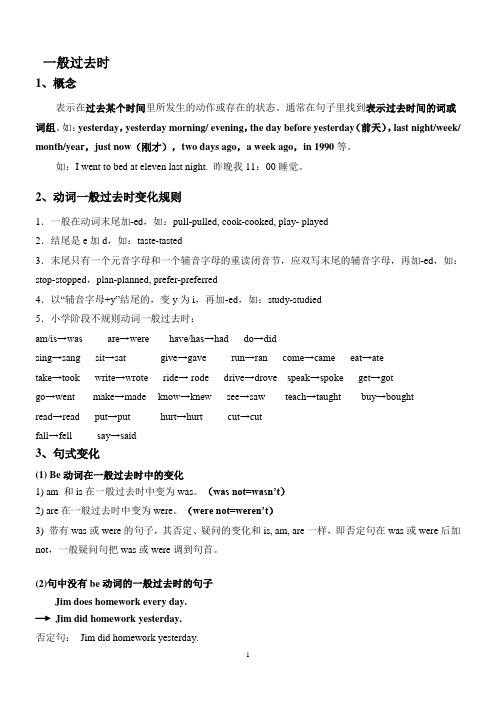
一般过去时1、概念表示在过去某个时间里所发生的动作或存在的状态。
通常在句子里找到表示过去时间的词或词组。
如:yesterday,yesterday morning/ evening,the day before yesterday(前天),last night/week/ month/year,just now(刚才),two days ago,a week ago,in 1990等。
如:I went to bed at eleven last night. 昨晚我11:00睡觉。
2、动词一般过去时变化规则1.一般在动词末尾加-ed,如:pull-pulled, cook-cooked, play- played2.结尾是e加d,如:taste-tasted3.末尾只有一个元音字母和一个辅音字母的重读闭音节,应双写末尾的辅音字母,再加-ed,如:stop-stopped,plan-planned, prefer-preferred4.以“辅音字母+y”结尾的,变y为i,再加-ed,如:study-studied5.小学阶段不规则动词一般过去时:am/is→was are→were have/has→had do→didsing→sang sit→sat give→gave run→ran come→came eat→atetake→took write→wrote ride→ rode drive→drove speak→spoke get→gotgo→went make→made know→knew see→saw teach→taught buy→boughtread→read put→put hurt→hurt cut→cutfall→fell say→said3、句式变化(1) Be动词在一般过去时中的变化1) am 和is在一般过去时中变为was。
(was not=wasn’t)2) are在一般过去时中变为were。
深圳小学英语4下知识点总结及练习unit10
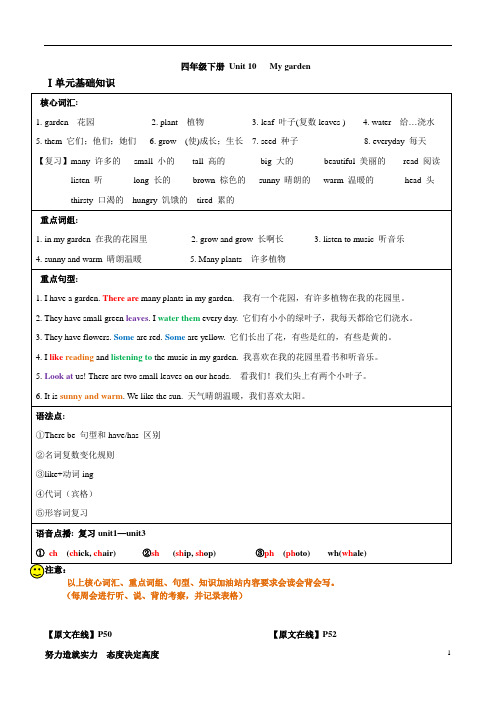
四年级下册Unit 10 My garden Ⅰ单元基础知识➢➢➢1.➢➢(每周会进行听、说、背的考察,并记录表格)【原文在线】P50 【原文在线】P52【小试牛刀】(根据My garden 回答下面问题) 1.What does the plants have?__________________________________ 2. What colour are the flowers?__________________________________ 3. What do I like doing in the garden?__________________________________Ⅱ 知识详解[词汇全解]1. Look at 看... 原文链接:Look at us!. 看我们! 【拓展】①.See, watch, look, read 的区别① See “看见,看到”,强调看的结果 see a film 看电影 see the doctor 看医生(看病) ② Look 强调看的动作 look at this picture 看这张图片③ Watch “观看”,强调看活动,非静止画面 Watch TV 看电视 Watch a match 看比赛 ④ Read “阅读”,与文字有关的东西 read book/ magazine/ newspaper 读书/杂志/报纸②.look 的固定搭配look at 看 look after 照顾 look for 寻找 have a look 看一看【牛刀小试】 填入see 、look 、watch 、read 使句子完整。
①.I would like to ___ newspapers(报纸) when I am free. ②.He stands at the window and __ a policeman. ③.____!The bus is coming.My garden① I have a garden. There are many plants in my garden. They have small green leaves. I water them every day. The plants grow and grow. ② Now my plants are tall and big. They have flowers. Some are red. Some are yellow. They are all beautiful. I like reading and listening to music in my garden. Two seeds① We are seeds. We are small and brown.② It rains. We are thirsty. We drink the rain water.③ It is sunny and warm. We like the sun.④ Look at us! There are two small leaves on our heads.⑤ We grow and grow. We have big leaves.⑥ Now we have yellow flowers.④.The little boy likes ____TV very much.⑤.He will go to ___a volleyball match.⑥.How many birds can you ___ in the tree?⑦.Does Lily often go to ___ a film(电影) on Sunday?2.【复习】人称代词【原文链接】I water them every day. 我每天给他们浇水。
深圳小学课本四年级下册第4单元知识点
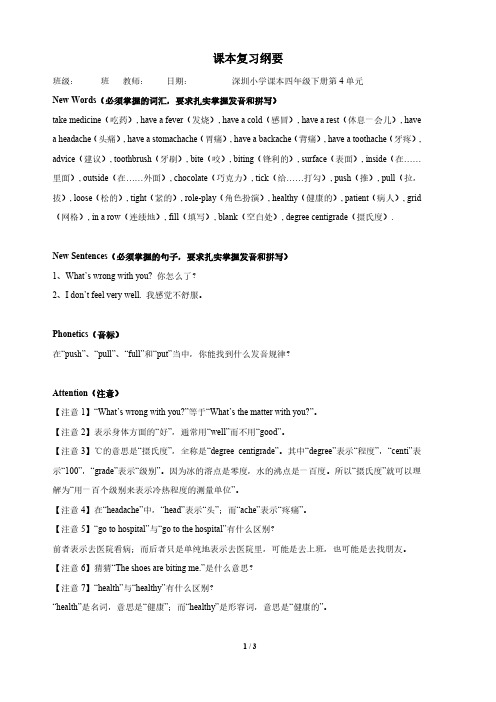
课本复习纲要班级:班教师:日期:深圳小学课本四年级下册第4单元New Words(必须掌握的词汇,要求扎实掌握发音和拼写)take medicine(吃药), have a fever(发烧), have a cold(感冒), have a rest(休息一会儿), have a headache(头痛), have a stomachache(胃痛), have a backache(背痛), have a toothache(牙疼), advice(建议), toothbrush(牙刷), bite(咬), biting(锋利的), surface(表面), inside(在……里面), outside(在……外面), chocolate(巧克力), tick(给……打勾), push(推), pull(拉,拔), loose(松的), tight(紧的), role-play(角色扮演), healthy(健康的), patient(病人), grid (网格), in a row(连续地), fill(填写), blank(空白处), degree centigrade(摄氏度).New Sentences(必须掌握的句子,要求扎实掌握发音和拼写)1、What’s wrong with you? 你怎么了?2、I don’t feel very well. 我感觉不舒服。
Phonetics(音标)在“push”、“pull”、“full”和“put”当中,你能找到什么发音规律?Attention(注意)【注意1】“What’s wrong with you?”等于“What’s the matter with you?”。
【注意2】表示身体方面的“好”,通常用“well”而不用“good”。
【注意3】℃的意思是“摄氏度”,全称是“degree centigrade”。
其中“degree”表示“程度”,“centi”表示“100”,“grade”表示“级别”。
粤教版英语四年级 下册

粤教版英语四年级下册一、单词。
1. 动物类。
- cat(猫),dog(狗),rabbit(兔子),duck(鸭子),chicken(鸡)等。
这些单词可以通过动物图片来记忆,例如展示猫的图片同时说出“cat”这个单词,多重复几次加深印象。
- 还可以进行单词拼写练习,如cat:c - a - t。
2. 颜色类。
- red(红色),blue(蓝色),green(绿色),yellow(黄色),black(黑色),white(白色)等。
可以用彩色卡片来辅助学习,一面是颜色,一面是对应的英文单词。
- 做一些简单的颜色问答练习,如:What color is the apple? It's red.3. 日常用品类。
- book(书),pen(钢笔),pencil(铅笔),ruler(尺子),bag(书包)等。
把这些物品放在桌子上,指着物品说英文单词,然后让学生重复并拼写。
- 例如:This is a pen. P - e - n.二、句型。
1. 描述事物特征。
- It's...(它是……)- 例如:It's a big cat.(它是一只大猫。
)- 可以通过描述教室里的物品或者图片中的物品来练习这个句型,如指着一幅大象的图片说:It's a big elephant.2. 询问事物是什么?- What's this/that?(这/那是什么?)- 回答:It's...- 进行情景对话练习,如把一个物品放在盒子里,让学生问What's this?然后回答It's a pencil.3. 描述颜色。
- It's...(颜色)- 如:The flower is red.(这朵花是红色的。
)- 可以做一个“猜颜色”的游戏,一个人描述一个物品的颜色特征,其他人来猜这个物品是什么。
三、语法。
1. 单复数。
- 在四年级下册中,开始接触简单的单复数概念。
2024四年级英语知识点及复习提纲
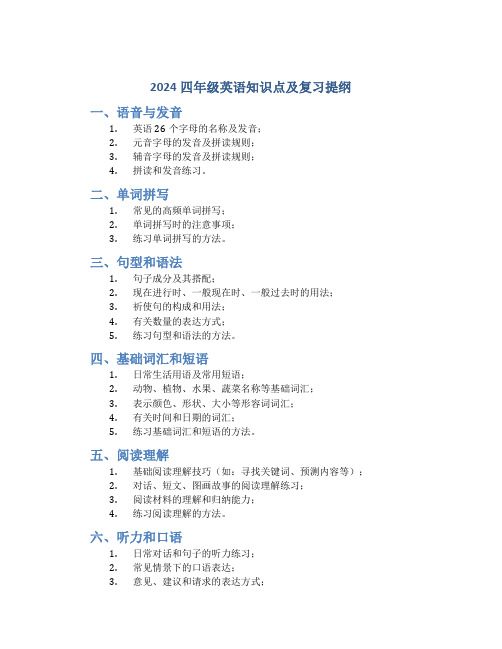
2024四年级英语知识点及复习提纲
一、语音与发音
1.英语26个字母的名称及发音;
2.元音字母的发音及拼读规则;
3.辅音字母的发音及拼读规则;
4.拼读和发音练习。
二、单词拼写
1.常见的高频单词拼写;
2.单词拼写时的注意事项;
3.练习单词拼写的方法。
三、句型和语法
1.句子成分及其搭配;
2.现在进行时、一般现在时、一般过去时的用法;
3.祈使句的构成和用法;
4.有关数量的表达方式;
5.练习句型和语法的方法。
四、基础词汇和短语
1.日常生活用语及常用短语;
2.动物、植物、水果、蔬菜名称等基础词汇;
3.表示颜色、形状、大小等形容词词汇;
4.有关时间和日期的词汇;
5.练习基础词汇和短语的方法。
五、阅读理解
1.基础阅读理解技巧(如:寻找关键词、预测内容等);
2.对话、短文、图画故事的阅读理解练习;
3.阅读材料的理解和归纳能力;
4.练习阅读理解的方法。
六、听力和口语
1.日常对话和句子的听力练习;
2.常见情景下的口语表达;
3.意见、建议和请求的表达方式;
4.练习听力和口语的方法。
七、写作技巧
1.简单的对话、日记、便条、小广告的写作;
2.句子的结构和词汇的运用;
3.表达感情和描述事物的方式;
4.练习写作技巧的方法。
以上是2024年四年级英语知识点及复习提纲,希望同学们在学习过程中能够按照提纲逐步复习,提高英语学习成绩。
深圳小学英语四年级下册知识点复习

深圳小学英语四年级下册知识点复习一. Unit 1.GOOD HABITS一.重点词汇。
when 当…时候 early 早的 usually通常 breakfast早餐brush 刷 tooth 牙齿(teeth 复数) wash洗 comb 梳头finish 完成homework 家庭作业pack 包装hang up 悬挂brush my teeth刷牙 wash my face洗脸 pack my schoolbag 整理书包finish homework完成家庭作业 good habits好习惯 comb my hair梳头hang up my clothes 挂起衣服in hospital住院hurry up赶快put on穿上 Silly me我真傻! once a day一天一次 come on加油二.重点句型。
1. When do you get up? I get up at six thirty in the morning.2. How often does she wash her face? She washes her face twice a day.3. She has good habits.4. What do you do in the morning?5. There’s no school today.三.重点语法。
1. It’s time for sth.(n);It’s time to do sth 例如:It’s time for school./It’s time to go to school. 到上学的时间了。
2. do 和does 的用法does 用于第三人称单数(she,he,it ,Tom等)do 用于第一人称,第二人称,第三人称复数(I,you,we,they,等)3. when 引导的特殊疑问句。
When do you(第二人称,第三人称复数,)+(动词原形)…?你什么时候做…?When does he/she(第三人称单数) + (动词原形)…?他/她什么时候做…?例句:When do you get up ?你什么时候起床?When does she/he get up ?他/她什么时候起床?4. 用 How often 来对频率提问:How often do you + (动词原形)…?How oftendoes+(第三人称单数)+动词原形…?表示频率的次数来回答。
2020深圳四年级英语下册各单元重点归纳

Unit 1 Touch and feel A.Words & Phrasestouch 喷;触摸feel 摸起来;感到soft柔软的hard坚硬的thick厚的;粗的thin薄的;细的young年轻的noise响声‘吵闹声’blind瞎的;失明的under a tree在树下hear a noise听到响声well done干得不错touch the elephant摸一摸大象B Extension (反义词)cold-hot tall-short long-short new-old young-old happy-sad full-hungry sweet-bitter thin-thick thin-fatsoft-hard small-big open-close fast-slow beautiful-ugly rough-smoothB.Key Sentences1. How does it feel?感觉它怎么样?2.It’ s soft/ hard.它是软的/硬的。
D Language Focus1.---Touch it. How does it feel? ---It’s soft.(1)特殊疑问句“ How does it feel?”询问对方触摸某物有什么感觉,用于单个物品或某些不可数名词,用“It’s…(形容词)”或“ It feels…(形容词)”来回答。
例如:---Touch this desk. How does it feel?摸摸这张桌子。
感觉它怎么样?---It’s hard/ It feels hard.它是硬的。
---Touch the bread. How does it feel?摸摸这个面包。
感觉它怎么样?---It ‘s soft. /It feels soft.它是软的。
(2)“ How do they feel?”用于询问触摸多个物品有什么感觉,回答用“ They are…,(形容词)”或“ They feel…(形容词)”。
【深圳市】人教版小学四年级英语下册知识点及复习要点
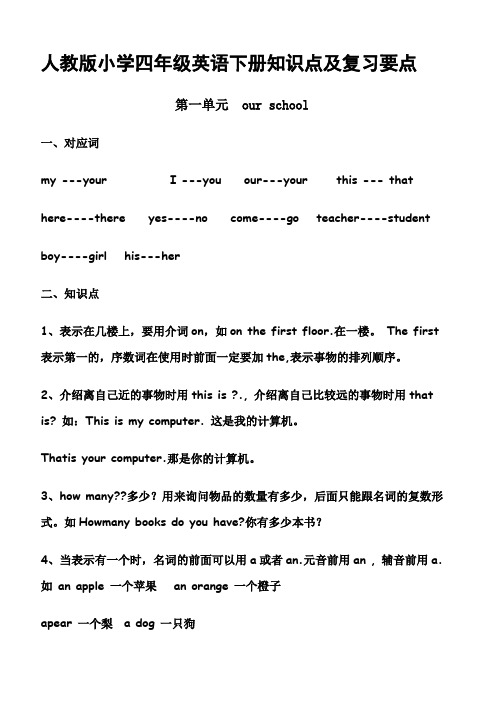
人教版小学四年级英语下册知识点及复习要点第一单元our school一、对应词my ---your I ---you our---your this --- thathere----there yes----no come----go teacher----studentboy----girl his---her二、知识点1、表示在几楼上,要用介词on,如on the first floor.在一楼。
The first 表示第一的,序数词在使用时前面一定要加the,表示事物的排列顺序。
2、介绍离自己近的事物时用this is ?., 介绍离自己比较远的事物时用that is? 如:This is my computer. 这是我的计算机。
Thatis your computer.那是你的计算机。
3、how many??多少?用来询问物品的数量有多少,后面只能跟名词的复数形式。
如Howmany books do you have?你有多少本书?4、当表示有一个时,名词的前面可以用a或者an.元音前用an , 辅音前用a.如 an apple 一个苹果 an orange 一个橙子apear 一个梨 a dog 一只狗5、当用Is this?? Is that??提问时,一般用肯定回答是:Yes, it is.否定是: No , it isn’t.三、句子:1、This is the te acher’s office.这是老师办公室。
2、That is my classroom.那是我的教室。
3、Go to the library. Read a story-book..去图书馆。
读故事书。
4、Is this the library? Yes, it is.这是图书馆吗?是的。
5Isthat the art room? The art room is on the second floor. 那是美术室吗?不是,美术室在二楼。
小学生四年级第二学期英语下册(译林版)期末复习各单元知识归类、重点归纳

小学生四年级第二学期英语期末复习各单元知识归类(重点归纳)Unit 1 知识归类一、词组1.our school subjects 我们的学校课程2.Welcome back to school.欢迎回到学校。
3.Nice to see you.见到你很高兴。
4.our new timetable我们的新课程表5.Music and Science 美术和科学6.what subjects什么课程7.Chinese and Maths 语文和数学8.go to the playground 去操场9.It’s time for PE.该是上体育课的时间了。
10.what lessons 什么课11.this morning/afternoon 今天早上/下午12.on Monday 在星期一13.have English and Maths 有英语课和数学课14.make a cake 制作一块蛋糕15.an Art lesson 一节美术课 16.at school 在学校17.don’t like that 不喜欢那样 18.don’t skate 不要滑冰二、句型1.What subjects do you like? 你喜欢什么课程?I like.../We like...2.What subjects do you have?你有什么课程?I have.../We have...3.Let’s go to the playground.让我们去操场吧。
4.--Nice to see you.--Nice to see you too.三、语音a / ei /cake grape make skate Kate timetable name table四、语法1.It’s time for +名词。
如:It's time for school.该是上学的时候了。
to+动词…如: It's time to go to school.2.Let's …让我们…如: Let’s go to the playground.3.don’t =do not五、作文My school subjectsI have seven subjects at school.They are Chinese, Maths, English, Music, Art, PE and Science.I like PE.It’s fun.(I like Chinese and English.They’re fun.)I don’t like Maths.It’s difficult.(难的,困难的)Unit 2 知识归类一、词组1.after school 放学后2.go and play table tennis去打乒乓球e and play table tennis 来打乒乓球4.What a pity!真遗憾!5.have a football match 有一场足球比赛6.All right.好的。
深圳小学英语四年级下:反身代词与指示代词

反身代词与指示代词Part Ⅰ熟读下列短语B. 1. a messy cupboard杂乱的碗橱 2. clean walls 干净的墙壁3. a full sink满满的水槽4. be healthy健壮的5. clean up清扫干净6. clean and tidy 干净又整洁7. dirty and messy 脏而乱8. four slices of bread 四片面包9. a teaspoon of salt 一茶匙盐10. turn—over将---翻过来Part Ⅱ一、反身代词I can do it by myself. 我自己能做这件事。
*反身代词的构成规律记忆口诀:反身代词有规律,第三人称宾格加,其余开头用物主,复数-ves替-f【用法展现】1 可用作宾语,指的是宾语和主语表示同一个或同一些的人或事物。
如:Maria bought herself a scarf. 玛丽亚给自己买了一条围巾。
We must look after ourselves very well. 我们必须好好照顾自己。
2 可用作表语,指的是表语和主语表示同一个或同一些人或事物。
如:She isn’t quite herself today. 她今天有点不舒服。
3 可用作主语或宾语的同位语,常用来加强语气。
如:She herself will fly to London tomorrow. 明天她自己将要坐飞机去伦敦。
I met the writer himself last week. 我上周见到了那位作家本人。
练习:1. The old man lives by ______.2. I am sure I can do it all by _______.3. Look, is this room beautiful? I painted it _____.4. Mary is old enough to take care of ______.5. Can you carry this box upstairs by _______.6. The story ______was very good, but you did not tell it well.7. Did all of you enjoy _______at the party yesterday?8. One should not praise _______.9. We can finish this task by _______.10. Some of my classmates are not quite _______these days.二、指示代词This (这个)------- these (这些) 指近处的事物That (那个)------- these (那些) 指远处的事物例,This is a book. 这是本书。
【深圳市】四年级英语下册知识点归纳
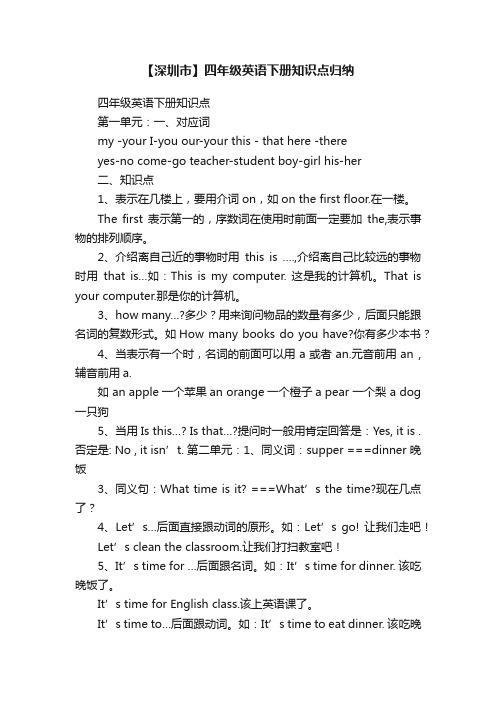
【深圳市】四年级英语下册知识点归纳四年级英语下册知识点第一单元:一、对应词my -your I-you our-your this - that here -thereyes-no come-go teacher-student boy-girl his-her二、知识点1、表示在几楼上,要用介词on,如on the first floor.在一楼。
The first表示第一的,序数词在使用时前面一定要加the,表示事物的排列顺序。
2、介绍离自己近的事物时用this is ….,介绍离自己比较远的事物时用that is…如:This is my computer. 这是我的计算机。
That is your computer.那是你的计算机。
3、how many…?多少?用来询问物品的数量有多少,后面只能跟名词的复数形式。
如How many books do you have?你有多少本书?4、当表示有一个时,名词的前面可以用a或者an.元音前用an , 辅音前用a.如 an apple一个苹果an orange一个橙子a pear 一个梨 a dog 一只狗5、当用Is this…? Is that…?提问时一般用肯定回答是:Yes, it is .否定是: No , it isn’t. 第二单元:1、同义词:supper ===dinner 晚饭3、同义句:What time is it? ===What’s the time?现在几点了?4、Let’s…后面直接跟动词的原形。
如:Let’s go! 让我们走吧!Let’s clean t he classroom.让我们打扫教室吧!5、It’s time for …后面跟名词。
如:It’s time for dinner. 该吃晚饭了。
It’s time for English class.该上英语课了。
It’s time to…后面跟动词。
- 1、下载文档前请自行甄别文档内容的完整性,平台不提供额外的编辑、内容补充、找答案等附加服务。
- 2、"仅部分预览"的文档,不可在线预览部分如存在完整性等问题,可反馈申请退款(可完整预览的文档不适用该条件!)。
- 3、如文档侵犯您的权益,请联系客服反馈,我们会尽快为您处理(人工客服工作时间:9:00-18:30)。
一. Unit 1.GOOD HABITS一.重点词汇。
when 当…时候 early 早的 usually通常 breakfast早餐brush 刷 tooth 牙齿(teeth 复数) wash洗 comb 梳头finish 完成homework 家庭作业pack 包装hang up 悬挂brush my teeth刷牙 wash my face洗脸 pack my schoolbag整理书包finish homework完成家庭作业 good habits好习惯 comb my hair梳头hang up my clothes 挂起衣服in hospital住院hurry up赶快put on穿上 Silly me我真傻! once a day一天一次 come on加油二.重点句型。
1. When do you get up? I get up at six thirty in the morning.2. How often does she wash her face? She washes her face twice a day.3. She has good habits.4. What do you do in the morning?5. There’s no school today.三.重点语法。
1. It’s time for sth.(n);It’s time to do sth 例如:It’s time for school./It’s time to go to school. 到上学的时间了。
2. do 和does 的用法does 用于第三人称单数(she,he,it ,Tom等)do 用于第一人称,第二人称,第三人称复数(I,you,we,they,等)3. when 引导的特殊疑问句。
When do you(第二人称,第三人称复数,) +(动词原形)…?你什么时候做…?When does he/she(第三人称单数) + (动词原形)…?他/她什么时候做…?例句:When do you get up ?你什么时候起床?When does she/he get up ?他/她什么时候起床?4. 用 How often 来对频率提问:How often do you + (动词原形)…?How oftendoes+(第三人称单数)+动词原形…?表示频率的次数来回答。
(once,twice,three times,four times---)例句:How often do you wash your face ?你多久洗一次脸?I wash my face twice a day. 我一天洗两次脸。
How often does Sam wash his face ?Sam多久洗一次脸?He washes his face twice a day. 他一天洗两次脸。
5. 句型:First ,Next, Then , After that …先后顺序表达。
例如:First ,I get up early. Next, I brush my teeth .Then,I comb my hair . After that ,I eat breakfast .UNIT 2 MANNERS一.重点词汇。
manner 礼仪 quiet 安静的 library 图书馆 corridor 走廊polite 礼貌的 rude 粗鲁的 noisy 吵闹的 rubbish bin 垃圾箱floor 地板 go away出去 should 应该 Model student模范生run/walk in the corridors在走廊上跑/走 throw rubbish one the floor把垃圾扔在地上 well done干得好throw rubbish in the bin 把垃圾扔进垃圾桶 school rules校规二.重点句型。
1. Pease don't throw rubbish on the floor!2. You shouldn’t be rude. You shoud be polite.3. Do you want to be a model student?4. Who’s a model student this year?5. She’s polite and helpful, too.三.重点语法。
1. 祈使句:提出请求,建议或发出命令的句子。
如:Throw rubbish in the bin, please . 请把垃圾扔到垃圾篓。
Don’t run in the corridors. 不要再走廊里跑.Be polite. 有礼貌! Be queit. 保持安静。
Don’t be rude. 不要无礼。
Don’t be noisy. 不要吵闹。
2.should 应该,应当,否定形式shouldn’t.should, may, must, can, need例如:He should be polite. 他应该有礼貌。
She shouldn’t run in the classroom.她不应该在教室里跑。
UNIT3 SEASONS一.重点词汇。
season 季节 website 网站 weather天气 different 不同的 spring 春天summer 夏天 autumn 秋天 winter 冬天 place 地方 warm 温暖的cool 凉爽的 because因为 rain 下雨 snow 下雪 ride a bike骑自行cool and dry凉爽干燥 make a snowman堆雪人 a fun holiday有趣的假日read a poster 阅读海报 go for a swim去游泳 the ugly duck丑小鸭fly away 飞走了 mother duck母鸭 fly a kite放风筝二.语法重点。
1.介词in后接时间的用法早、午、晚要用ineg. in the morning/afternoon/evening在早上/下午/晚上in the day在白天b. 年、月、年月、季节、第几周前用ineg. in Spring/in summer/in autumn/in winter在春天/夏天/秋天/冬天 in April在四月 in 1987在1987年 in April 1987在1987年4月 in the first week of this month这个月的第一个星期2.be from=come from来自---Where are you from? I am from …Where is she/ he from? She/He is from …Where do you come from? I come from …Where does she/he come from? She/He comes from …3. 问某地天气:What’s the weather like in+(地方)in+(季节)?eg. What’s the weather like in Harbin in winter? It often snows4.Why 是问原因的特殊疑问句,回答时用Because 引导句子。
UNIT 4一.重点词汇。
sick 生病 toothbrush牙刷 chocolate巧克力 surface表面take some medicine 吃药 go to hospital 去医院(专指去看病)go to a clinic 去诊所 have a fever 发烧 have a cold 感冒have a rest 休息 have a headache 头痛 have a stomachache 胃痛二.重点句型。
1. What’s the matter?2. You need to go to hospital and see the doctor.3. You should also drink a lot of water and stay in bed.4. You should brush you teeth with a toothbrush like this one.5. Brush the inside/outside surface of your teeth.三.重点语法。
1.”What’s the matter+人名? 你怎么了?回答:I have a …. /We have a….例句:What’s the matter, Tim?怎么啦,Tim?I have a stomachache. 我胃痛。
同义句:What’s wrong with+人名?2.注意吃药take some medicine 而不是 eat some medicine3. go to hospital go to the hospitalUnit 4一.重点词汇。
grow种植 soil土壤 light光 large大的 guess猜 bee蜜蜂root根部remember记得do an experiment做实验tonight今晚grow quickly/slowly 快速/缓慢生长 learn about学习 Group 2第二组a small/large pot一个大的/小的花盆three tomato plants三株西红柿fall on掉落 TV show电视节目 find out发现/找到二.重点句型。
1. We want to grow some tomatoes.2. How often should we water the plant?3. It needs a small pot of soil.4. Group 1, give this plant a little water once a day.5. What will happen?6. We are going to do an experiment.7. What do plants need?三.重点语法。
1. a little和little不可数 (a few和few可数)2. a lot of=lots of(可数+不可数)a lot of light大量光 a lot of pots许多花盆3. 一般将来时一般将来时表示将来的动作或状态。
常与表示将来的时态连用如tomorrow, next week, next month, next year, in a few days等。
